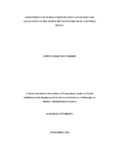ANTECEDENTS OF PUBLIC PARTICIPATION AND BUDGETARY ALLOCATION IN THE NORTH RIFT ECONOMIC BLOC COUNTIES, KENYA
Abstract
Budgetary allocation is used by most governments and public institutions as an instrument for proper management of public funds. Achieving this presupposes that the citizenry, from whose taxation governments pull funds for budgeting, participate in the allocation process. This research thus endeavored to appreciate aspects that influence participation by members of the public for sound budgetary allocation. The constitution stipulates pertinent prerequisites at both the national and county government levels for the legislative arm of government to establish public participation guidelines in the process of governance and decision making on public policy. The general objective of the study was to establish the effects of antecedents of public participation on budgetary allocation in the north rift economic block counties. To address this overall objective, the study set out to determine how citizen awareness, economic factors, demographic characteristics and behavioral factors influence budgetary allocation; and whether the influence is moderated by public participation. The research was anchored on Agency theory, Stakeholders theory and Arnstein’s Ladder of Citizen Participation theory. The study took on the explanatory study design and targeted 10,690 individuals including elected leaders, county budgetary and planning staff, sub location development committee and county ward administrators. The study utilized a sample size of 320. Multistage sampling technique was used to select the respondent. A questionnaire was used to collect data. Both descriptive and inferential statistical analyses were carried out on the quantitative data. Under inferential analysis, regression analysis was used to predict the effect of antecedents of public participation on budgetary allocation in the north rift economic counties. The study found that citizen awareness (β = .884, p = .000<.05) had a significant effect while out of the three demographic factors, only education level of participants has a significant effect on budgetary allocation (β = .139, p = .000<.05), while participant age (β = .003, p = .943>.05) and gender (β = .021, p = .773>.05) did not significantly influence budgetary allocation. Behavioral factors (β = 1.064, p = .000<.05) and economic factors (β = .903, p = .000<.05) were also found to have a positive and significant effect on budgetary allocation. Public participation was also found to significantly mediate the association between citizen awareness (β=.4075, LL=.3530, UL=.4651), demographic characteristics (β=.6582, LL=.5689, UL=.7330), behavioural factors (β=.2552, LL=.1957, UL=.3164), economic factors (β=.2706, LL=.2257, UL=.3171) and budgetary allocation. Based on the findings it is concluded that the community involvement is crucial for a successful and sustainable public development project especially during budgeting process. Through public discussion, deliberation, and negotiation on budget issues, participatory budgeting increases the range of citizen participation and enhances the citizens’ awareness of the whole budget process. It is thus recommended that citizens and the community at large need to be sensitized on the importance of taking part in public participation so as to enhance budgetary allocation effectiveness.

